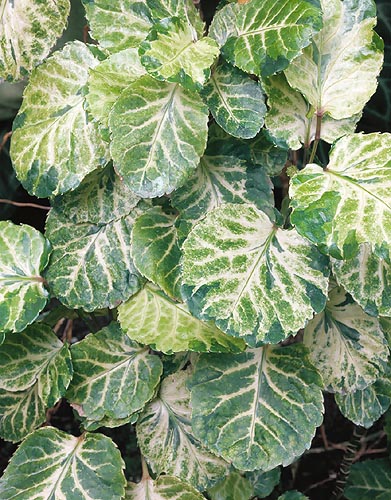Family : Araliaceae

Text © Pietro Puccio

English translation by Mario Beltramini

Good indoor plant, but irritating leaves © Giuseppe Mazza
The name of the genus comes from the combination of the Greek words “polys” = much and “skia” = shade, with possible reference to the thick foliage; the species is honoured to the English botanist John Hutton Balfour (1808-1884).
Common names: “Balfour aralia”, “Balfour polyscias”, “dinner plate aralia”, “plate aralia” (English); “aralia de Balfour”, “baglio” (French); “arália redonda”, “arvore-da-felicidade”, “arália-cortina” (Portuguese); “aralia Balfour” (Spanish); “Fiederaralie” (German).
Shrub, or small evergreen tree, with vertical appearance, growing to about 6 m tall, with branches remaining for long time green, dotted of grey; the leaves, with 5-20 cm long petioles, are usually trifoliate (simple on the young plants), with rounded small leaves, of about 5-20 cm of diameter, with indented or crenate margin, white at times; the variety ‘Pennockii’ (see photo) has greenish white maculae along the median nervations.
The inflorescences are terminal, erect, 30-80 cm long, panicle, with greenish flowers assembled in umbrellas, hermaphrodite in the terminal umbrella and male in the lateral ones, of about 6 mm of diameter; globose, 4-6 mm long, fruits.
It reproduces by seed, air layering, woody cutting and semi-woody apical cutting in confined space.
Plant cultivated outdoors in the tropical and humid subtropical regions, often utilized as border, or isolated, in full sun or slight shade on rich soils, kept constantly humid. When in pot, it is common as indoor plant, appreciated for its vertical standing, and the rather slow growth which permits to contain its dimensions for long time; furthermore, it bears well the pruning which allow to thicken it, when necessary, and to change its look.
It requires a luminous exposition, especially for the variegated leaf varieties, and a high humidity, in case to be increased with nebulisations in presence of dry air and high temperatures, utilizing water with ambient temperature and not calcareous, to avoid un-aesthetic dots on the leaves; the temperatures are to be over the 16°C, best at 20-22°C, and watering, abundant in summer, are to be reduced in winter, leaving the loam to partly dry up between the watering.
All the parts of the plant contain saponins, substances which can be irritating for the skin and for the mouth mucosae.
Synonyms: Aralia balfouriana André (1898); Panax balfourii Pynaert ex Sand. (1899).
→ To appreciate the biodiversity within the ARALIACEAE family please click here.
